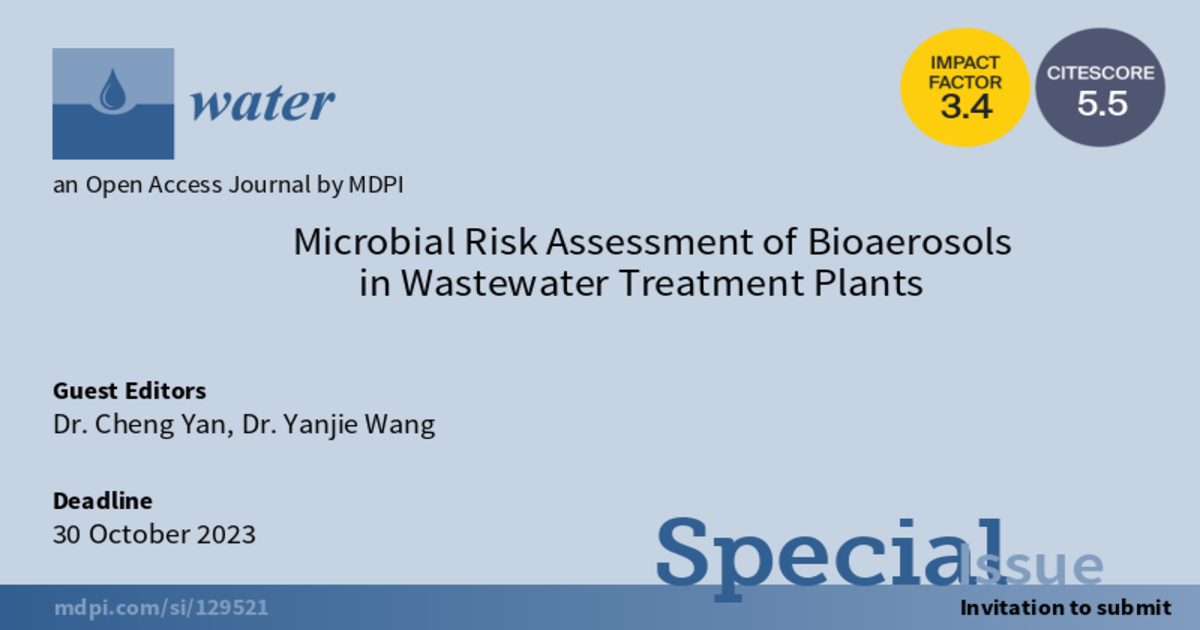Microbial Risk Assessment of Bioaerosols in Wastewater Treatment Plants
A special issue of Water (ISSN 2073-4441). This special issue belongs to the section "Water and One Health".
Deadline for manuscript submissions: closed (30 October 2023) | Viewed by 4252

Special Issue Editors
Interests: quantitative microbial risk assessment; microbiological contamination in environments; assessment and methodology; public and human health; bioaerosol; bioaerosol sensor; airborne microorganisms and biological particles; bio-fluorophore particles; laser-induced fluorescence
Special Issues, Collections and Topics in MDPI journals
Special Issue Information
Dear Colleagues,
Air aeration and mechanical agitation operations are the most important approaches to biological treatment in wastewater treatment plants (WWTPs). However, they produce numerous bioaerosols that harbor pathogens. These bioaerosols are mainly ingested through the pharynx or nares and can cause a range of adverse health effects, such as sewage worker's syndrome. Therefore, bioaerosol risk characteristics and measures to reduce their risk in WWTPs have attracted increasing attention.
Microbial risk assessment is a framework intended for the quantitative estimation of health risks in occupational exposure scenarios. It is carried out as follows: (i) hazard identification, (ii) exposure assessment, (iii) dose–response assessment, and (iv) risk characterization.
The Special Issue is now open for submissions. The findings presented in this Special Issue could contribute toward the establishment of mitigation measures and control strategies for the management of public health risks from the exposure to bioaerosols in local utilities.
Dr. Cheng Yan
Dr. Yanjie Wang
Guest Editors
Manuscript Submission Information
Manuscripts should be submitted online at www.mdpi.com by registering and logging in to this website. Once you are registered, click here to go to the submission form. Manuscripts can be submitted until the deadline. All submissions that pass pre-check are peer-reviewed. Accepted papers will be published continuously in the journal (as soon as accepted) and will be listed together on the special issue website. Research articles, review articles as well as short communications are invited. For planned papers, a title and short abstract (about 250 words) can be sent to the Editorial Office for assessment.
Submitted manuscripts should not have been published previously, nor be under consideration for publication elsewhere (except conference proceedings papers). All manuscripts are thoroughly refereed through a single-blind peer-review process. A guide for authors and other relevant information for submission of manuscripts is available on the Instructions for Authors page. Water is an international peer-reviewed open access semimonthly journal published by MDPI.
Please visit the Instructions for Authors page before submitting a manuscript. The Article Processing Charge (APC) for publication in this open access journal is 2600 CHF (Swiss Francs). Submitted papers should be well formatted and use good English. Authors may use MDPI's English editing service prior to publication or during author revisions.
Keywords
- bioaerosols
- health risk
- wastewater treatment plant
- exposure assessment
- dose–response model
- risk characterization
- risk assessment
Benefits of Publishing in a Special Issue
- Ease of navigation: Grouping papers by topic helps scholars navigate broad scope journals more efficiently.
- Greater discoverability: Special Issues support the reach and impact of scientific research. Articles in Special Issues are more discoverable and cited more frequently.
- Expansion of research network: Special Issues facilitate connections among authors, fostering scientific collaborations.
- External promotion: Articles in Special Issues are often promoted through the journal's social media, increasing their visibility.
- Reprint: MDPI Books provides the opportunity to republish successful Special Issues in book format, both online and in print.
Further information on MDPI's Special Issue policies can be found here.






